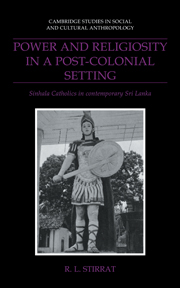Book contents
- Frontmatter
- Contents
- List of maps and figures
- List of tables
- Acknowledgements
- List of abbreviations
- Glossary
- Map 1 Sri Lanka
- Map 2 The west coast of Sri Lanka
- 1 Introduction
- 2 The colonial Church
- 3 The Church in crisis
- 4 The rise of Kudagama
- 5 Demonic possession and the battle against evil
- 6 Suffering and sacrifice
- 7 Holy men and power
- 8 Patronage and religion
- 9 On the borders
- 10 Conclusion
- Notes
- List of references
- Index
- Cambridge Studies in Social and Cultural Anthropology
4 - The rise of Kudagama
Published online by Cambridge University Press: 02 December 2009
- Frontmatter
- Contents
- List of maps and figures
- List of tables
- Acknowledgements
- List of abbreviations
- Glossary
- Map 1 Sri Lanka
- Map 2 The west coast of Sri Lanka
- 1 Introduction
- 2 The colonial Church
- 3 The Church in crisis
- 4 The rise of Kudagama
- 5 Demonic possession and the battle against evil
- 6 Suffering and sacrifice
- 7 Holy men and power
- 8 Patronage and religion
- 9 On the borders
- 10 Conclusion
- Notes
- List of references
- Index
- Cambridge Studies in Social and Cultural Anthropology
Summary
Introduction
The most famous of these new shrines is that of Our Lady of Lourdes in a village called Kudagama. This and the next two chapters are all primarily concerned with this shrine, with its rise to fame and with the sort of religiosity which the shrine represents. It must be remembered, however, that Kudagama is not representative in any simple sense of Sinhala Catholicism as a whole: many Sinhala Catholics, both lay and clergy, reject what goes on there. Furthermore, in one crucial respect it is also unrepresentative of the other new shrines which have developed in Sri Lanka. Kudagama centres around a priest in holy orders whilst the other new shrines are focused on laymen who claim a particular charism. Yet Kudagama is in many ways the model for these other shrines, and it was by far the most popular of all the holy places which developed in Sri Lanka in the 1970s.
This chapter describes the rise of Kudagama, the sort of rituals which take place there, how the sacred is constructed at the shrine, and the relation between this shrine and the wider Catholic Church and community in Sri Lanka. The next two chapters are concerned with the symbolic analysis of behaviour at Kudagama, particularly with the ways in which suffering is understood and elaborated. In many ways the story of Kudagama is a story of how a rather odd young man, Camillus Jayamanne, became for many Catholics the most powerful priest in the island, and of how a quiet backwater of Sinhala Catholicism became, depending on one's taste, the most holy place in Sri Lanka, a centre of regressive superstition, or a dangerous threat to the unity and teachings of the Church.
- Type
- Chapter
- Information
- Power and Religiosity in a Post-Colonial SettingSinhala Catholics in Contemporary Sri Lanka, pp. 58 - 77Publisher: Cambridge University PressPrint publication year: 1992



